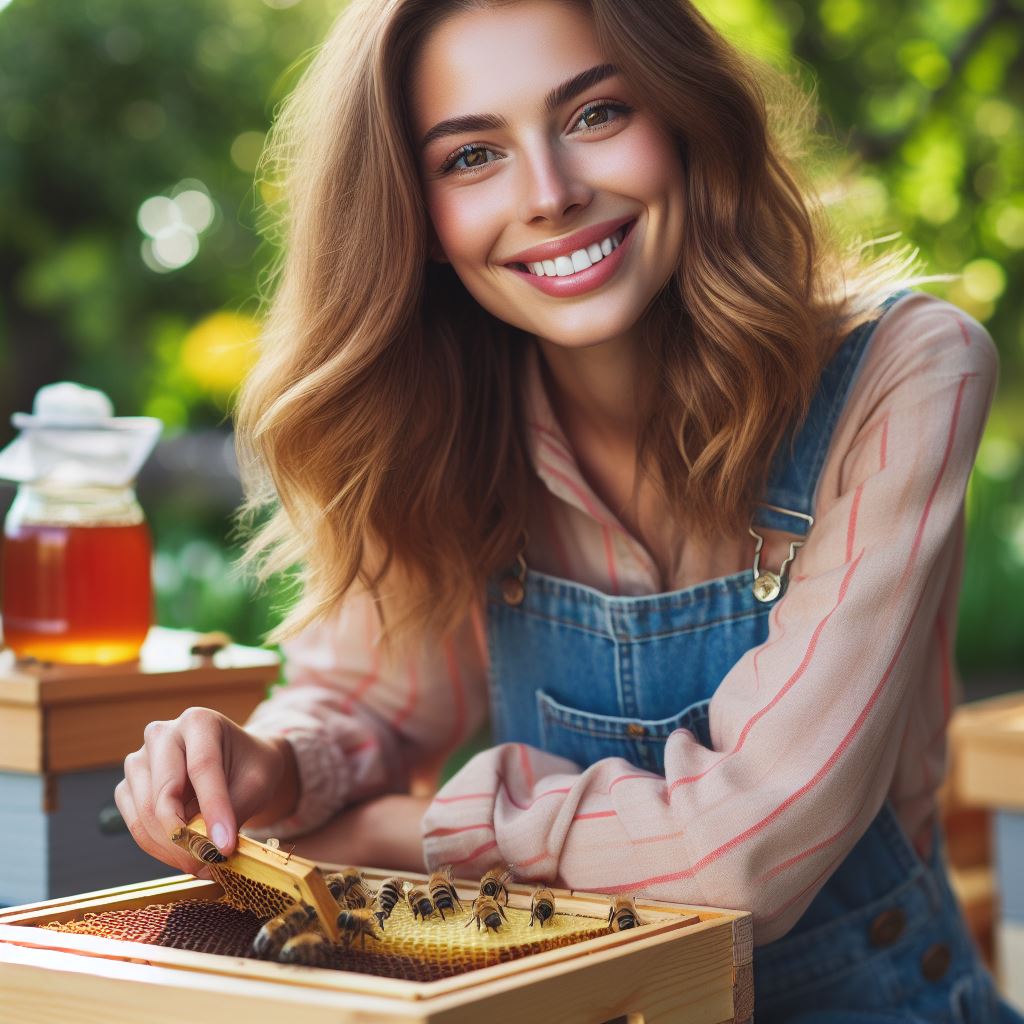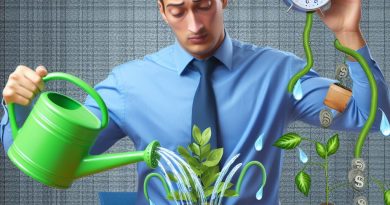Urban Beekeeping: Boost Your Garden’s Yield
Last Updated on February 9, 2024
Introduction
In this section, we will explore the concept of urban beekeeping and its benefits for garden yield.
Urban beekeeping refers to the practice of keeping beehives in cities and urban areas.
Bees play a crucial role in pollination, which is essential for the growth and yield of plants in gardens.
Without bees, many plants would struggle to reproduce, resulting in lower yields of fruits, vegetables, and flowers.
Urban beekeeping offers several advantages, such as increased pollination rates, improved biodiversity, and enhanced garden productivity.
By introducing beehives into urban environments, gardeners can benefit from higher crop yields and more abundant harvests.
Bees also contribute to the overall health of gardens by pollinating a wide variety of plants, increasing their genetic diversity.
Additionally, urban beekeeping promotes environmental awareness and supports the conservation of honeybees, which are facing numerous challenges.
In fact, urban beekeeping is an innovative and beneficial practice for gardeners seeking to boost their garden’s yield.
By harnessing the power of bees, gardeners can enjoy thriving gardens with increased productivity and a greater variety of healthy and abundant crops.
Getting Started with Urban Beekeeping
Choosing the right location for hives in an urban setting
- Select a location that offers shelter from extreme weather conditions like strong winds and direct sunlight.
- Ensure the hive is placed in an area that is easily accessible for regular maintenance and monitoring.
- Avoid placing hives close to areas with high foot traffic to minimize disturbances to the bees.
- Consider the proximity of nearby flowering plants, as bees require a diverse source of nectar and pollen.
- Check if there are any local zoning regulations that prohibit or restrict beekeeping in certain areas.
Researching local regulations and obtaining necessary permits
- Contact your local municipality or urban planning department to inquire about beekeeping regulations.
- Obtain any necessary permits or licenses required to keep bees in an urban environment.
- Ensure compliance with any guidelines regarding hive placement, number of hives allowed, and safety precautions.
Selecting the appropriate type and size of beehive
- Consider the space available in your urban setting when choosing the type of beehive.
- Langstroth hives are popular for their modular frames and easily expandable design.
- Top-bar hives are ideal for limited spaces and do not require heavy lifting during inspection.
- Warre hives are aesthetically pleasing and require minimal intervention, making them suitable for beginners.
Acquiring bees from a reputable source
- Search for reputable beekeepers or apiaries in your area to purchase colonies or nucs.
- Ensure that the bees are healthy and disease-free by requesting a health certificate.
- Consider purchasing locally adapted bees, as they are more suited to the urban environment.
- Transport the bees safely and transfer them to the prepared hive following recommended guidelines.
Ensuring access to adequate food and water sources for bees
- Plant a variety of bee-friendly flowers, herbs, and shrubs that bloom throughout the seasons.
- Ensure the availability of a clean water source nearby, such as a shallow dish with stones for bees to drink safely.
- Encourage your neighbors to create bee-friendly gardens to enhance the foraging area for bees.
- Monitor the food and water sources regularly to ensure they remain abundant for the bee colony.
Starting urban beekeeping requires careful consideration of various factors, including choosing the right location for hives.
The hive should be sheltered and easily accessible for maintenance, while avoiding high foot traffic areas.
It’s crucial to research local regulations and acquire necessary permits before starting beekeeping in an urban environment.
Additionally, selecting the appropriate type and size of beehive is important based on available space and individual preferences.
Acquiring bees from a reputable source ensures the health and quality of the colony.
Furthermore, providing adequate food and water sources for bees is essential for their survival and productivity.
Planting bee-friendly flora and ensuring a clean water source nearby helps sustain the bees.
By following these guidelines, you can embark on a successful journey in urban beekeeping and enjoy the benefits it brings to your garden.
Read: Aquaponics: Fish Types & Plant Choices
Benefits of Urban Beekeeping for Garden Yield
Increased pollination rates and improved fruit/vegetable production
- Urban beekeeping significantly boosts pollination rates, leading to higher yields in your garden.
- Bees are efficient pollinators, ensuring that flowers are properly fertilized, resulting in abundant fruits and vegetables.
- Increased pollination enhances the quality, size, and flavor of your garden’s produce.
- Bee activity improves the yield of crops such as tomatoes, peppers, cucumbers, berries, and melons.
- The presence of bees ensures better pollination on fruit trees, resulting in a higher harvest.
Enhanced biodiversity and ecological harmony in the garden
- Beekeeping promotes biodiversity by attracting various native pollinators in addition to honeybees.
- Having a diverse group of pollinators enhances the overall health and productivity of the garden.
- Bee-friendly plants and flowers cultivate a harmonious ecosystem, benefiting other insects and wildlife.
- Urban beekeeping contributes to the conservation of local bee species, helping maintain a balanced ecosystem.
- Increased flower diversity due to beekeeping attracts beneficial insects that control garden pests naturally.
Better resistance to pests and diseases
- Bees improve the overall health and resistance of plants by aiding in their pollination process.
- Proper pollination results in stronger plants with enhanced immune systems, making them more resilient to diseases.
- Bees help increase a garden’s resistance to pests as healthier plants can better withstand pest infestations.
- Urban beekeeping minimizes the need for chemical pesticides, promoting organic and sustainable gardening methods.
- By maintaining a balance in the garden ecosystem, bees contribute to pest control and limit infestation risks.
Improved seed production and plant reproduction
- Bee pollination increases seed production, ensuring a robust population of plant varieties in your garden.
- Well-pollinated plants produce higher-quality seeds with better genetic traits and improved viability.
- Bees aid in cross-pollination, promoting genetic diversity among plants and enhancing seed adaptability.
- Urban beekeeping helps preserve heirloom plant varieties by ensuring their continuity through proper pollination.
- By facilitating plant reproduction, bees play a crucial role in maintaining the biodiversity of plant species.
By incorporating urban beekeeping into your gardening practices, you can reap a multitude of benefits.
Not only will your garden yield increase due to enhanced pollination rates, but you will also enjoy healthier plants with better resistance to pests and diseases.
Creating a harmonious and biodiverse ecosystem in your garden will not only benefit your plants but also support the conservation of valuable bee species.
Moreover, the improved seed production and genetic diversity resulting from bee pollination contribute to the long-term sustainability of your garden.
Embrace urban beekeeping and witness the remarkable impact it can have on your garden’s yield and ecological well-being.
Read: Biocontrol: Nature’s Pest Management

Managing and Maintaining Urban Beehives
Regular hive inspections and monitoring of bee health
- Hive inspections should be conducted at regular intervals to ensure the health of the bees.
- Inspect the frames for signs of disease, pests, or any abnormalities.
- Check the brood pattern and look for the presence of the queen.
- Monitor the population size and overall activity levels of the hive.
- Properly document and record the findings from each inspection for future reference.
Providing necessary equipment and supplies for beekeeping
- Invest in high-quality beehives, preferably with removable frames for easier inspections.
- Ensure the availability of sufficient frames, honey supers, and bottom boards for expansion.
- Provide protective gear such as bee suits, gloves, and veils for safety during hive management.
- Keep an adequate supply of sugar syrup or pollen substitute to supplement the bees’ diet if needed.
- Have a smoker and hive tool on hand for easier manipulation of the hive.
Understanding and practicing proper beekeeping techniques
- Stay informed about the latest beekeeping practices and techniques through courses or workshops.
- Handle bees gently and avoid sudden movements or loud noises that may agitate them.
- Use sustainable and organic methods to manage pests and diseases without harming the bees.
- Ensure the bees have access to a variety of blooming flowers throughout the year for proper nutrition.
- Avoid overharvesting honey and leave enough for the bees to sustain themselves over the winter.
Identifying and addressing common challenges and issues
- Be aware of common issues like swarming, queenlessness, or robbing and take immediate action if needed.
- Monitor and control mites, such as Varroa destructor, which can severely impact bee health.
- Address aggressive behavior by requeening or providing more space for the bees.
- Prevent or mitigate pesticide exposure by locating hives away from treated areas.
- Consult experienced beekeepers or local beekeeping associations for guidance when facing challenges.
Seasonal hive management and maintenance tasks
- Regularly clean and maintain the beehive equipment to prevent the buildup of debris or pathogens.
- Monitor the hive’s honey and pollen stores to ensure the bees have sufficient food for winter.
- Perform necessary hive manipulations, such as adding or removing supers based on nectar flow.
- Protect the hive from extreme weather conditions by providing proper insulation or ventilation.
- Prepare the hive for winter by reducing the entrance size, insulating or wrapping it, and feeding if necessary.
By implementing proper hive management and maintenance techniques, urban beekeepers can foster healthy and productive colonies, ultimately boosting their garden’s yield.
Read: Mini Orchard: Fruit Trees in Containers
Safety Considerations and Tips for Urban Beekeeping
Communicating with neighbors and addressing concerns
One important aspect of urban beekeeping is establishing open lines of communication with neighbors.
Address any concerns they may have and educate them about the benefits of bees in the neighborhood.
Regularly update neighbors about the progress of your beekeeping project, helping to build trust and understanding.
Using protective gear and practicing proper hive handling
Wearing protective gear, such as a bee suit, veil, and gloves, is crucial during beekeeping activities.
Follow proper hive handling techniques, such as smoking the hive to calm bees and using gentle movements.
By wearing protective gear and handling hives correctly, you minimize the risk of bee stings and accidents.
Educating oneself about bee behavior and warning signs
Before starting urban beekeeping, it is important to educate yourself about bee behavior and warning signs.
Learn to recognize signs of aggression or distress in bees, such as increased buzzing or defensive postures.
Understanding these behaviors will allow you to take appropriate actions to ensure your safety and the bees’ well-being.
Taking precautions to reduce risks of stings and allergies
To prevent bee stings and minimize the risk of allergic reactions, take necessary precautions.
Avoid wearing dark-colored clothing and perfumes, as they can attract bees.
Keep beekeeping areas well-maintained and free from clutter, reducing the likelihood of accidental disturbances.
Knowing when to seek professional help
While urban beekeeping can be a rewarding hobby, there may be situations where professional assistance is needed.
If you encounter a swarm or suspect any problems with your hives, consult an experienced beekeeper or local beekeeping association.
Seeking professional help ensures the safety of both you and the bees, preventing potential mishaps or issues.
By prioritizing safety considerations and following these tips, you can enjoy the benefits of urban beekeeping while keeping risks at bay.
Remember, safety should always be the top priority when engaging in this fulfilling and environmentally-friendly practice.
Read: Urban Jungle: Tropical Plants in Pots
Harvesting and Utilizing Honey and Bee Products
Timing and processes for honey extraction
- Determine the right time to harvest honey by observing when the bees seal the cells.
- Remove the honey supers from the hive using a bee escape or bee brush to minimize bee disturbance.
- Remove the wax capping on each frame of honey using a hot knife or uncapping fork.
- Place the uncapped frames in an extractor and spin them to extract honey.
- Filter the extracted honey to remove impurities and debris.
- Store the extracted honey in clean, airtight containers to maintain its quality and freshness.
Proper storage and labeling of harvested honey
- Store honey in a cool, dry place away from direct sunlight to prevent crystallization and fermentation.
- Use glass jars or food-grade plastic containers with tight-fitting lids for honey storage.
- Label each jar with the harvest date, type of honey, and any additional information such as floral source or region.
- Include nutrition facts, allergy information, and contact details on the label for consumer safety and regulatory compliance.
- Properly seal and protect the label to ensure it remains intact and legible throughout the product’s shelf life.
Exploring other bee products like beeswax, propolis, and pollen
- Beeswax can be harvested by melting the honeycomb and removing impurities.
- Beeswax has various uses, including candles, beauty products, and woodworking.
- Propolis, a resin-like substance, can be collected from the hive and used for its antibacterial and medicinal properties.
- Pollen, collected by bees from flowers, can be consumed as a nutritional supplement or used in skincare products.
Creative uses and recipes incorporating honey and bee products
- Use honey as a natural sweetener in beverages, baked goods, and salad dressings.
- Make homemade beeswax candles or lip balms using beeswax and essential oils.
- Create a healing salve by combining propolis, beeswax, and olive oil.
- Incorporate pollen into smoothies, energy bars, or sprinkle it on top of yogurt and desserts.
- Experiment with honey-based recipes such as honey-glazed salmon or honey-infused herbal teas.
By harvesting and utilizing honey and other bee products, not only can you enjoy the fruits of your urban beekeeping efforts, but you can also enhance the overall yield and diversity of your garden.
Remember to follow proper timing, extraction processes, and storage techniques to maintain the quality and value of these natural treasures.
Be creative and explore the numerous ways honey and bee products can enrich your culinary and self-care experiences.
Conclusion
Recap of the benefits of urban beekeeping for garden yield
Urban beekeeping offers several benefits for garden yield.
The presence of bees increases pollination rates, resulting in higher fruit and vegetable production.
This can lead to a more abundant garden harvest.
Encouragement to explore urban beekeeping as a way to boost garden productivity
If you want to maximize your garden’s yield, consider exploring urban beekeeping.
It is a sustainable and rewarding practice that can significantly enhance the productivity of your garden.
Final thoughts on the importance of supporting pollinators in urban environments
Supporting pollinators, such as bees, in urban environments is crucial for maintaining biodiversity and food security.
By creating a bee-friendly garden, you contribute to the well-being of our ecosystem and ensure a healthier future for all.


